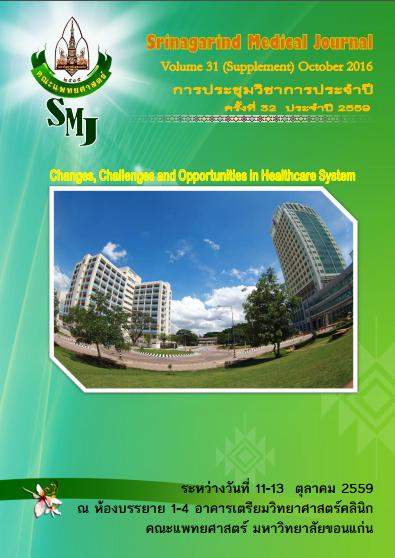Proportions of Khon Kaen University Students which Live in Dormitory who have Sufficient Knowledge about Food and Food Preparation that Increase Risk of Opisthorchisviverrini Infection and Cholangiocarcinoma
Keywords:
Opisthorchisviverrini infection, cholangiocarcinoma, food, food preparation, KhonKaenUniversity studentsAbstract
Background and Objective: Thailand has the highest incidence rate of cholangiocarcinoma in the world. Previous studies on the knowledge of this disease were mostly performed in the middle-aged population. However, college students, who are expected to receive sufficient knowledge from the preventive campaignof this disease which has been launched since the past ten years, have not been explored for their knowledge. This study aimed to examine: 1) proportions of KhonKaen University students who had sufficient knowledge about food and food preparation that increase risk of Opisthorchisviverrini infection and cholangiocarcinoma; 2) proportions of KhonKaen University students who had sufficient knowledge about Opisthorchisviverrini infection and cholangiocarcinoma; and 3) types of food and food preparation related to these diseases but commonly misunderstood.
Method: Descriptive study, at KhonKaen University. Population: A total of 357 undergraduate KhonKaen University students who live in the campus were recruited using a systematic sampling from a total of 9,689 people. Tools and measurement: a self-administered questionnaire. Data analyses: SPSS v. 19 and Epi Info v. 3.5.4 were used to analyzed proportions, frequency and 95% Confidence interval.
Results: The response rate was 93.83 %( 335/357). In all, 12 (3.7%, 95%CI: 1.99, 6.47) Khon Kaen University students had sufficient knowledge about food and food preparation that increase risk of Opisthorchisviverrini infection and cholangiocarcinoma. The number of students who hadsufficient knowledge about food at risk of Opisthorchisviverrini infection was 82 (24.6%). A total of 202 persons (61.0%) misunderstood about food preparation, of which the most common misunderstood method was soft-boiled. The most frequently reported misunderstood types of food included cooked fermented fish, pickled crab and raw shrimp. Forty one persons (12.3%) reported misunderstood about nitrosamine-rich food.
Conclusion: There was a small number of KhonKaen University students having sufficient knowledge regarding Opisthorchisviverrini infection and cholangiocarcinoma. The most common reported insufficient knowledge was nitrosamine-rich food and food that had metacercaria of liver fluke.




